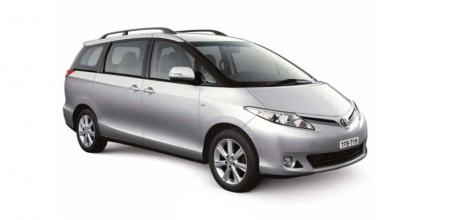1999 Toyota Tarago
A belated farewell to a people-mover revolution
Not to say there’s causation, but the world went a bit pear-shaped when the Toyota Tarago left us. The people mover of choice for tens of thousands of Aussies ended production in the final weeks of 2019, since replaced by the more luxo-bent Granvia. But this page of Wheels hasn’t paid homage to the trusty Tarago until now.
First introduced to Australia in 1983 as our own version of what was called the TownAce (and the unfortunately named MasterAce), the Toyota Tarago was effectively a passenger van body plonked onto the chassis of a commercial vehicle, though with slightly upgraded components for a more car-like drive. A note in Wheels February 1983 points out the “soon-for-release MasterAce Grand Saloon has coil-spring rear suspension and an aerodynamic nose”.
But it was in the 1990s that Tarago, named for a town in NSW, really found its footing. After making a name for itself badge-wise, the Tarago came close to winning our 1991 Car of the Year.
The second generation, called Previa in Japan, was all-new, with Toyota claiming nothing was carried over from the previous model. It was a far more modern “aerodynamic egg” design, as then-editor Phil Scott called it in December 1989, featuring a mid-mounted engine, strut front and multi-link rear suspension, and almost perfect weight distribution. All of which made the Tarago exceptional, at considerable expense to Toyota.
At Car of the Year in 1991, judge John Carey called it “the most significant piece of design this year”; Peter Robinson said it was a “quantum leap forward in people movers”. In the end, the Lexus LS400 won COTY, but the four judges who didn’t vote for it voted for one other car: Tarago. One of those judges was Colin Bond!
Up to the turn of the century, Toyota shifted more than 60,000 Taragos between its first two generations, before the arrival of the third generation in 2000. Once again, Toyota claimed there were no parts in common with the previous model, though this time the Tarago wasn’t entirely built as a unique vehicle. Tarago 3.0 shared its chassis and underpinnings with the Camry sedan, meaning the engine was now mounted in the front, and the floor and seats were now lower to the ground.
While perhaps not as revolutionary as the second version, the third Tarago sold 16,000 units across its six years, a number the fourth generation would take a decade to match after going on sale in 2006. That generation would be the last for the Tarago. In an ironic twist, the car-based van would give way to a new model with the same genesis as the original Tarago.
The Toyota Granvia, a larger, more luxury-focused van takes the place of Toyota’s people mover. Its basis? The new Toyota HiAce van. What’s clear is Toyota believes the new platform is more economical to produce, as well as driving well enough to have appeal as a passenger vehicle.
But not a patch on that second-generation Tarago in terms of revolutionising the segment.
THE PEOPLE REMAIN MOVED
The Tarago is a tough act to follow, but it seems the Granvia may be capable. Starting at $65K and reaching only into the mid-$70Ks, the single-drivetrain range (with a 2.8-litre turbo-diesel four from the Prado) features six- or eight-seater options across two variants, base or upper-spec VX. Multilink coil-sprung rear suspension is still there, at least, to create a comfortable ride for passengers.
AUSSIE SALES
- 1999 – 1887
- 2000 – 2726
- 2001 – 2561
- 2002 – 2925
- 2003 – 2736
- 2004 – 2930
- 2005 – 2794
- 2006 – 3161
- 2007 – 3920
- 2008 – 2949
- 2009 – 1907
- 2010 – 1460
- 2011 – 858
- 2012 – 1031
- 2013 – 960
- 2014 – 1059
- 2015 – 907
- 2016 – 900
- 2017 – 958
- 2018 – 738
- 2019 – 618
- 2020 – 124
- 2021 – 6
Total – 104,977(1983-2021)


